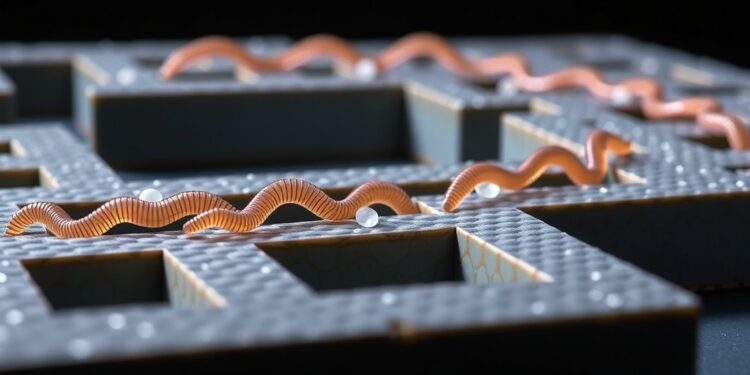In the realm of physics and biology, a groundbreaking revelation challenges long-standing assumptions about movement in crowded environments. Researchers at the University of Amsterdam have discovered that worms exhibit a strikingly different pattern of locomotion in complex surroundings, behaving in a manner that defies traditional expectations. While it is commonly understood that increasing obstacles in a crowded environment results in decreased mobility—consider the frustrating experience of navigating through a packed metro station—the scientists observed that worms actually move quicker when faced with greater density of obstacles. This unexpected behavior inspired a thorough examination of how these organisms navigate their environments.
The team’s findings were published in the esteemed journal Physical Review Letters, where they shed light on the unique locomotion strategies employed by worms as they maneuver through a maze of randomly scattered barriers. This research not only enhances our understanding of these creatures but also suggests broader implications for biological entities in similar environments, such as human bodies, and even robots operating in complex terrains. The study positions the worm as a model organism, providing valuable insight for the field of active matter physics.
Worms, with their elongated, flexible bodies, resemble active polymers on the microscopic level. Their unique morphology enables them to exhibit behaviors significantly different from those of larger and more rigid creatures, such as humans. As the researchers delved deeper into the mechanics of worm locomotion, they hypothesized that the polymer-like properties inherent to these organisms play a critical role in their ability to thrive in crowded spaces. Instead of hindrance, the presence of obstacles allowed the worms to navigate in a manner that resembles molecular dynamics, where the chaotic arrangement of barriers creates beneficial interactions.
The experimental setup involved introducing living worms into a controlled environment populated with fixed obstacles, establishing a paradigm to observe their dynamic interactions. The analysis included not only the live movements of the worms but also simulations based on an active polymer model. This dual approach provided a robust framework to compare and contrast observed behaviors with theoretical predictions and to discern how environmental structuring impacted movement.
One of the most revealing aspects of the study was the revelation that not all configurations of obstacles have the same effect on speed. When the obstacles were systematically organized in an ordered formation, the worms decreased their velocity as the obstacle density increased, conforming to conventional wisdom about crowd dynamics. In contrast, it was in disordered formations that the worms exhibited enhanced movement. In these chaotic settings, obstacles create narrow pathways or “tubes” that facilitate rapid traversal, allowing the worms to wiggle through with surprising efficiency.
Temperature also played an intriguing role. By cooling the worms’ environment, the researchers noticed that their activity level diminished, leading to an unforeseen outcome: instead of slowing down in a more structured environment, the worms became more adept at navigating through the space. This counterintuitive finding underscores the complex interplay between physical activity and environmental configuration, pushing the boundaries of our understanding regarding movement in biological systems.
To unpack these observations, researchers employed a statistical model designed to account for the distinct characteristics of active filaments, such as flexibility and movement dynamics. By integrating these parameters into their model, they were able to accurately simulate the behaviors recorded during experiments. The model highlighted the significant influence of obstacle arrangement on worm locomotion, illustrating that their ability to navigate is accentuated in disordered environments due to the formation of advantageous passages.
From a broader perspective, the implications of this study stretch beyond the movement of worms in soil. The findings pave a path for applications involving bio-inspired engineering, especially in the design of robotic systems that can operate effectively in cluttered spaces. Understanding how organisms like worms adapt to their environments could lead to innovative designs in robots that mimic these biological strategies, enhancing their performance in tasks such as search and rescue operations or environmental monitoring in dense locations.
Furthermore, insights gleaned from researching locomotion in worms can also inform medical science, especially regarding how cells and microorganisms navigate through the congested internal environments of the human body. The principles identified in this study may hold key information about how pathogens spread or how immune cells traverse tissue, leading to advancements in treatment strategies for various ailments.
In conclusion, the University of Amsterdam’s research has opened a fascinating dialogue on the dynamics of movement in crowded spaces. By analyzing the parameters that guide worm locomotion and revealing their surprising capacity to travel faster amidst obstacles, the scientists have challenged established notions about movement dynamics. This work highlights the importance of environmental structure in determining how entities, both biological and mechanical, interact with their surroundings, and serves as a springboard for future studies in active matter.
Worms may be small, but their locomotion presents a colossal opportunity to rethink how movement operates across various fields of science and engineering, reshaping our understanding of movement in a crowded world.
Subject of Research: Not applicable
Article Title: Locomotion of Active Polymerlike Worms in Porous Media
News Publication Date: 26-Mar-2025
Web References: 10.1103/PhysRevLett.134.128303
References: Not applicable
Image Credits: Not applicable
Keywords
Active polymers, worm locomotion, crowded environments, statistical modeling, disordered obstacles, bio-inspired robotics, complex landscapes, movement dynamics, environmental structure, active matter physics.




